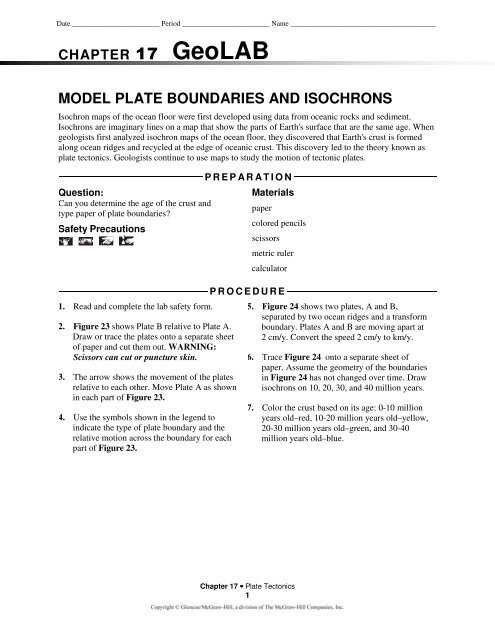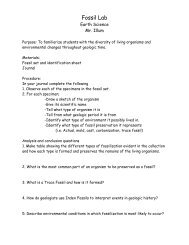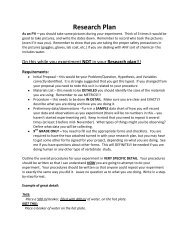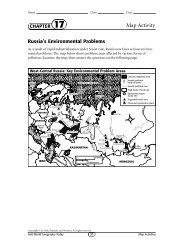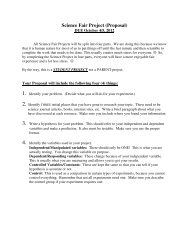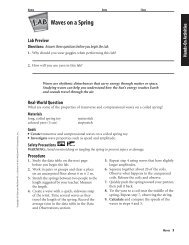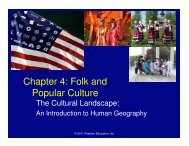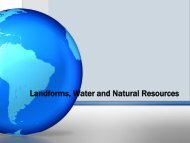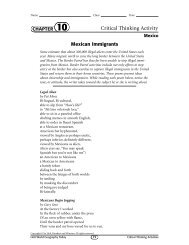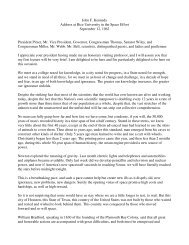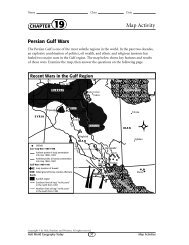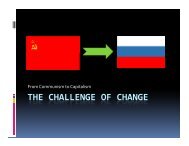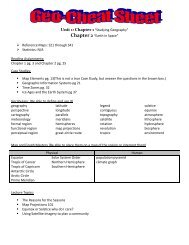Geolab: Modeling Plate Boundaries and Isochrons - legacyjr.net
Geolab: Modeling Plate Boundaries and Isochrons - legacyjr.net
Geolab: Modeling Plate Boundaries and Isochrons - legacyjr.net
- No tags were found...
You also want an ePaper? Increase the reach of your titles
YUMPU automatically turns print PDFs into web optimized ePapers that Google loves.
Date ________________________ Period ________________________ Name ________________________________________CHAPTER 17GeoLABMODEL PLATE BOUNDARIES AND ISOCHRONSIsochron maps of the ocean floor were first developed using data from oceanic rocks <strong>and</strong> sediment.<strong>Isochrons</strong> are imaginary lines on a map that show the parts of Earth's surface that are the same age. Whengeologists first analyzed isochron maps of the ocean floor, they discovered that Earth's crust is formedalong ocean ridges <strong>and</strong> recycled at the edge of oceanic crust. This discovery led to the theory known asplate tectonics. Geologists continue to use maps to study the motion of tectonic plates.Question:Can you determine the age of the crust <strong>and</strong>type paper of plate boundaries?Safety Precautions1. Read <strong>and</strong> complete the lab safety form.2. Figure 23 shows <strong>Plate</strong> B relative to <strong>Plate</strong> A.Draw or trace the plates onto a separate sheetof paper <strong>and</strong> cut them out. WARNING:Scissors can cut or puncture skin.3. The arrow shows the movement of the platesrelative to each other. Move <strong>Plate</strong> A as shownin each part of Figure 23.4. Use the symbols shown in the legend toindicate the type of plate boundary <strong>and</strong> therelative motion across the boundary for eachpart of Figure 23.P R E P A R A T I O NMaterialspapercolored pencilsscissorsmetric rulercalculatorP R O C E D U R E5. Figure 24 shows two plates, A <strong>and</strong> B,separated by two ocean ridges <strong>and</strong> a transformboundary. <strong>Plate</strong>s A <strong>and</strong> B are moving apart at2 cm/y. Convert the speed 2 cm/y to km/y.6. Trace Figure 24 onto a separate sheet ofpaper. Assume the geometry of the boundariesin Figure 24 has not changed over time. Drawisochrons on 10, 20, 30, <strong>and</strong> 40 million years.7. Color the crust based on its age: 0-10 millionyears old–red, 10-20 million years old–yellow,20-30 million years old–green, <strong>and</strong> 30-40million years old–blue.Chapter 17 <strong>Plate</strong> Tectonics1
GeoLABName ____________________________continuedKeyUse the following symbols to indicatethe type of plate boundary:Divergent boundaryConvergent boundary (triangles pointto the plate that stays on the surface)Transform; arrows indicate the relativedirection of motion across the boundaryFigure 23A B A B A Bsite 1 site 2 site 3Figure 24AB0 km 200 km 400 kmFigure 25Chapter 17 <strong>Plate</strong> Tectonics2
GeoLABName ____________________________continuedA N A L Y Z E A N D C O N C L U D E1. Determine the motion of a plate that would have each of the A sites that moved relative tothe B plate.________________________________________________________________________________________________________________________________________________________________________________________________________________________________________________________________________2. Apply From your map of isochrons, what is the easiest way to identify the location of transformboundaries?________________________________________________________________________________________________________________________________________________________________________________________________________________________________________________________________________3. Interpret Look at Figure 25. From the pattern of the isochrons on the ocean floor, identify thedivergent plate boundaries along the Atlantic, Ocean <strong>and</strong> along the Pacific Ocean.________________________________________________________________________________________________________________________________________________________________________________________________________________________________________________________________________________________________________________________________________________________________4. Differentiate Which ocean is marked by wider isochrons? Based on the amount of oceanic crustproduced in a given period of time, along which plate boundary is divergence happening morerapidly?________________________________________________________________________________________________________________________________________________________________________________________________________________________________________________________________________________________________________________________________________________________________________________________________________________________________________________________5. Infer The spreading center in the Pacific Ocean is not centered in the same manner as the AtlanticOcean. Explain how this indicates the presence of convergent plate boundaries.________________________________________________________________________________________________________________________________________________________________________________________________________________________________________________________________________________________________________________________________________________________________Chapter 17 <strong>Plate</strong> Tectonics3


